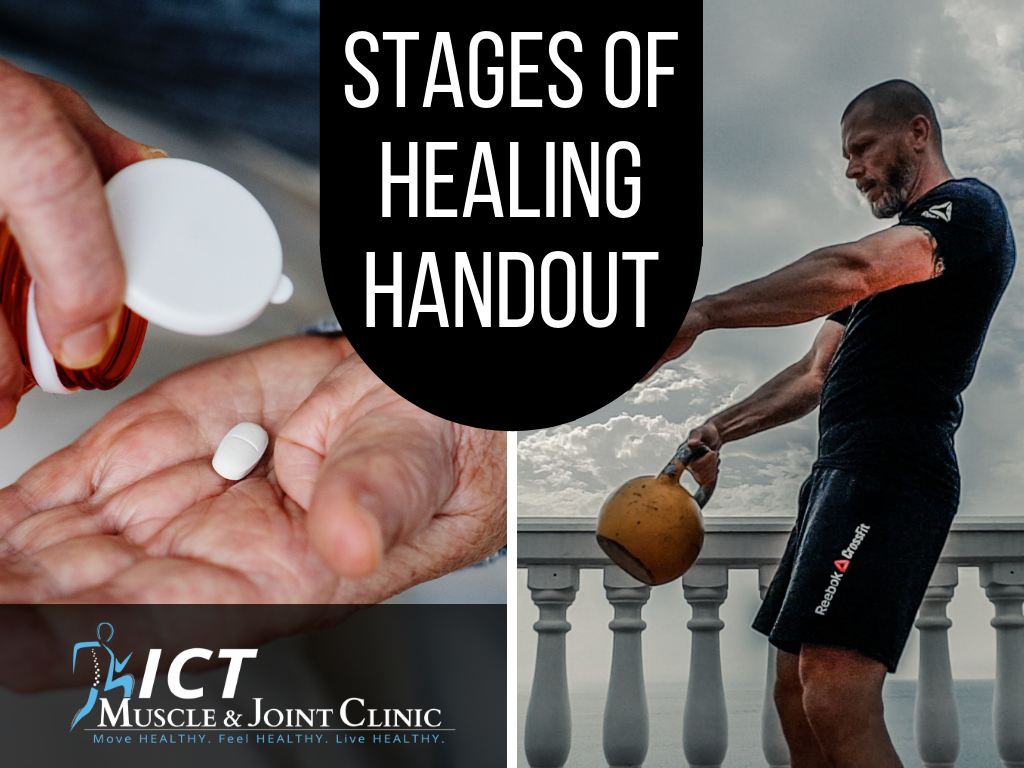Stages of Healing Handout
There are three stages of healing following an injury: inflammatory, proliferative, and remodel. Each phase of healing may take different amounts of time depending on the extent of the injury and tissue(s) injured. Recognizing which phase of healing you may be in is important for a speedy recovery. Be sure to ask your chiropractor about which phase of healing you are in during your journey to recovery.
Inflammatory stage: 1-2 weeks after injury
- First, recognize which type of inflammation you are in: chemical or mechanical. Once the pain is characteristic of mechanical pain follow the acronym MICE (comfortable range of motion, ice, compression, and elevation).
- Dr. Gabe Mirkin, creator of the acronym RICE, mentions “both ice and complete rest may delay healing, instead of helping.” Movement is therapeutic with pain being your guide.
- Find your baseline mid-range of movement, then move it. If it hurts, stop and rest. Don’t overdo this stage as it will delay recovery.
- Remember, too much of a good thing can become bad.
Proliferative stage: 2-4 weeks after injury
- This stage of healing is a transitional stage. If we push it to repair too fast, we can make it worse.
- Your body is starting to repair with scar tissue. Scar tissue can heal both poorly and beneficially. In the office, our goal is to plug in the right techniques or interventions, such as A.R.T, dry needling, FAKTR/ASTYM, or cupping to stretch and strengthen the scar tissue for it to heal as correctly as possible. At home, stick with midrange to full range movements or stretches with pain as your guide.
- As you perform your stretches, the phrase "no worse" is your pain guide. No worse is defined as having the same pain level or less after you complete a set of stretches. If the pain increases, then it means it is worse and therefore you have over-strained the area. At this point you must wait for the pain to come back down to baseline. If the pain lingers into the next day, you are in a re-flare up phase. At this point go back to at home inflammation treatment and talk with your chiropractor.
- Remember, different tissue(s) and the extent of an injury take different amounts of time to go through these phases correctly. The eager beaver is typically the last person to win the race.
Remodeling stage: 4th week and beyond
- This is the final stage of healing! At this point we switch from pain reduction exercises to performance exercises. It’s great to get out of pain, but many people will stop here and wonder why they never make lasting results.
- The goal is for you to start performing as many “normal” activities as you are used to. This might be walking or CrossFit – whatever is “normal” for you.
- Maximally challenging the tissue(s) and range(s) of motion becomes the focus.
- No worse is still your pain guide.
Resources
Caudill MA. Managing Pain Before It Manages You. Rev ed. New York: Guilford Press; 2002.
About the author
Dr. Keith Sparks is an award-winning chiropractor, functional medicine expert, and the co-founder of ICT Muscle & Joint Clinic. Dr. Sparks’ emphasis of care originated within the fields of rehabilitation, soft-tissue therapies, and chiropractic. To date, he has brought this unique combination of skills into union with functional medicine. The sole purpose of intertwining these distinct skills, knowledge, and services is to provide incomparable care to his local community. Dr. Keith Sparks is often seen in the Wichita, KS community speaking at business events and teaching health and performance classes.
